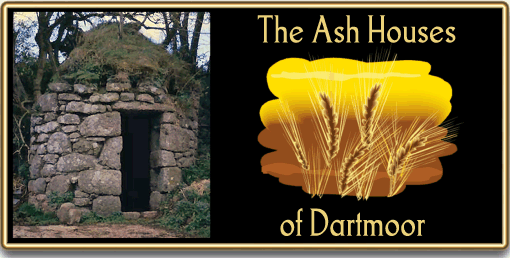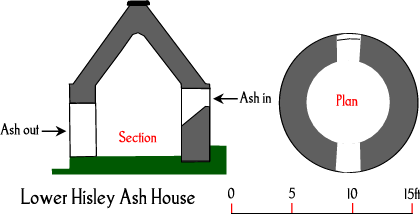
On many of the farms located on the arable fringes of the moor a common sight was the stone ‘ash house’. These are small circular buildings with conical roofs which would be located near to the farm. Back in the old days the combination of open fires, wide chimneys and thatched roofs presented a hazard, especially during the night, when the embers glowed and sparked unattended. To reduce this risk it was common practice to rake out the fires last thing at night and take the ash and embers out to the ash house. Worth (1988, p. 416) notes how in many cases taking out the ashes was a chore which befell upon the children of the family.
In many cases the ash house consisted of a small round stone built ‘house’ with a conical stone roof, the floors would be either earthen or lime-washed. They could either be of a simple design or in some cases rather ornate. Many of the moorland farms were located beside a road and often the ash house would be placed on the far side of it. If this was not possible the ash house would be sited well away from the house, in both cases the aim was to remove any risk of sparks landing in the thatch. There would be a small hatch on the farm-side of the house in which the ashes were dumped. On the opposite side was a larger doorway through which the ashes would be removed.

Adapted from Worth, p. 415.
There was also another style of house and that was the square version which was built in the same manner but with a single door through which the ash was tipped and removed. Worth (p.416) also mentions another design that was at Wrangaton Manor where the hatch to the ash house was at the back of the hearth. This meant the ashes could be tipped directly from the hearth into the house.
In the days before chemical fertilizers the ash house served a vital role on arable farms as the accumulated ash would be spread on the land. In this light it was also common practice to put any vegetable waste from the kitchen into the ash house where it would be mixed with the ash thus providing an extra source of nutrients. As the Dartmoor soils tend to be very much on the acidic side the ash was imperative to counterbalance this in order to grow healthy crops. It was not unknown for ash houses to have perches put in the roof space for the farmyard fowl to roost in. This again had two benefits, firstly the birds were protected from predators and secondly their droppings would also add to the nutrient value of the ash when it was spread on the fields. It is thought that the ash house tradition could possibly date back to the medieval period, there are certainly examples in Devon which are thought to have originated in the 13th century. It is estimated that today around about 30 – 35 ash houses survive on Dartmoor, mostly on the eastern fringes of the moor.
Very often the house would, as far as any children be concerned, be known as the ‘piskie house’. This is naturally because the tiny ‘houses’ were where the little folk lived and the reason their ‘back door’ faced away from the farmhouse was that they didn’t like being overlooked. At one time they were also likened to the ‘bee hive’ cells that occur in Ireland and some people assumed wrongly that they were dwellings of the moor folk.
Bibliography
Worth, R. H. 1988 Worth’s Dartmoor, David & Charles, Newton Abbot.
 Legendary Dartmoor The many aspects past and present of Dartmoor
Legendary Dartmoor The many aspects past and present of Dartmoor
